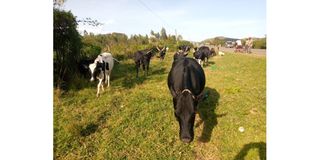Four districts on alert amid FMD outbreak

Cows graze at Nakisagya Village, Kaliiro Rural Sub-county in Lyantonde District in October last year. Due to the outbreak of Foot and Mouth Disease, there are restrictions on the sale and movement of animals. PHOTO | CATHERINE ANKUNDA
What you need to know:
- Authorities have warned farmers, traders and the general public against breaking the quarantine guidelines.
Farmers in four districts of central region are battling the Foot and Mouth Disease (FMD) outbreak that has resulted in a series of restrictions on the sale and movement of animals and their products to curb the disease spread.
The disease outbreak that was declared in the districts of Gomba, Ssembabule, Lyantonde and Lwengo by the respective authorities, comes at a time when Kyotera District, which is within the same cattle corridor, is battling the anthrax disease.
Anthrax, according to the Kyotera District technical team, is reportedly responsible for 18 human deaths and yet-to-be verified number of animal deaths.
Dr Resty Bairana, the Gomba District veterinary officer, yesterday said the FMD outbreak means that the farmers must adhere to measures set by the district to stop the spread of the disease to areas that are still safe.
“The quarantine on the animal movement also restricts the sale, purchase and slaughter of cattle, goats, sheep and pigs, as well as the sale of their products such as milk, butter, ghee, cow dung and yoghurt, among others,” she said on Tuesday.
Authorities in Gomba District have tentatively halted operations at the four livestock markets in Maddu, Kyayi, Kigezi and Kifamba Sub-counties while all slaughter places, including butcheries, will remain closed until the FMD is brought under control, a statement from the Gomba District Production Office, dated January 2, revealed.
Gomba District has already embarked on ring vaccination of animals in the affected areas after the Ministry of Agriculture, Animal Industry and Fisheries released 3,000 dozes for vaccination.
“I ask all the staff members, administrators, community leaders, security officers, livestock and dairy groups, cooperative societies, non-governmental organisations and the general public to comply with quarantine restrictions and support control measures as per guidelines and standard operating procedures. We are undertaking the vaccination in parts of areas affected,” the statement read in part.
The Gomba Resident District Commissioner, Ms Harriet Nakamya, on Tuesday warned the farmers, traders and the general public against breaking the quarantine guidelines.
“We have already informed the police in the affected sub-counties to arrest anyone who is not complying with any of the quarantine guidelines. The restrictions imposed by the ministry target the control and elimination of the disease and not punishing the farmers,” she said.
On December 27 last year, authorities in Lwengo District announced animal movement restrictions over suspected FMD and the anthrax disease outbreak in the sub-counties of Ndagwe and Kisekka.
Dr Samuel Mukuye, the Lwengo senior veterinary officer, said the restrictions targeted management of the suspected FMD and anthrax disease detected from the villages of Kiteredde, Mukondo Kiwangala.
Sembabule District has been battling the FMD since December 2023 when the authorities announced temporary restrictions on cattle market operations and animal movement, among other measures.
The Sembabule Chief Administrative Officer, Mr Malik Mahabba, on December 11, 2023, announced the quarantine measures on behalf of the Ministry of Agriculture, Animal Industry and Fisheries in the sub-counties of Lwebitakuli, Mijwala, Ntuusi and Mitima.
The FMD was also detected in Ntuusi Town Council in Sembabule District.
Background
The Foot and Mouth Disease (FMD) has been a recurrent disease in most of the cattle corridor districts in Central Uganda often leading to total ban on animal movement and the sale of animal products outside the affected areas.
FMD is an infectious animal disease that is at times fatal if not managed in time. FMD affects cloven-hoofed animals.
FMD is characterised by fever and blister-like lesions followed by erosions on the tongue and lips, in the mouth, on the teats, and between the hooves. Most affected animals recover, but the disease leaves them debilitated.
The virus disease is spread through contact with animal and animal products that are infected with the disease.






